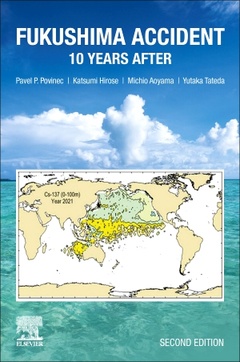Fukushima Accident (2nd Ed.) 10 Years After
Auteurs : Povinec Pavel P., Hirose Katsumi, Aoyama Michio, Tateda Yutaka

Fukushima Accident: 10 Years After evaluates the post-Fukushima accident situation with up-to-date information, emphasizing radionuclide impacts on the terrestrial and marine environments, and comparing them to the pre-Fukushima accident levels of radionuclides in the environment. This is based on scientific results, as well as knowledge gathered from literature to provide current information on the present status, summarize 10 years of data on the Fukushima accident, and describe the present situation in the local, regional, and global time and space scales. It provides data on radioactivity released into the atmosphere and the ocean, the distribution of radionuclides in the world atmosphere and oceans, and their impact on the total environment, including assessments of radiation doses in Japanese and world populations from consumption of terrestrial food and seafood. It goes on to describe future aspects of the radioactive contamination of these environments and the health implications.
This book informs environmental scientists, academics, and researchers in environmental science and nuclear energy as well as postgraduate students in the field of environmental science, radioactivity, and nuclear energy, on the present situation of radioactive contamination of Japan and in the world.
1. Introduction 2. Pre-fukushima radionuclide levels in the environment 3. Fukushima dai-ichi nuclear power plant accident 4. Releases of Radionuclide into The Environment 5. Radioactivity Impact on Japan 6. Radioactivity Impact on The World 7. Radiation Doses 8. Fukushima and Chernobyl 9. Outlook
Prof. Dr. Katsumi Hirose, Professor at the Laboratory for Environmental Research at Mount Fuji, Tokyo, former visiting Professor at the Sophia University in Tokyo, retired Head of the Geochemical Resear
- Covers the Fukushima radioactivity impact on humans and the environment from the accident to the present
- Provides full information on radiation doses to Japanese citizens and biota, as well as to the world population, 10 years after the Fukushima accident
- Details transport of radionuclides in terrestrial and ocean environments, describing how to apply this information to ocean global circulation models and quantify radionuclide contamination of coastal regions
- Assesses future trends in radioactive contamination of the Fukushima site
Date de parution : 07-2021
Ouvrage de 574 p.
15.2x22.8 cm
Thème de Fukushima Accident :
Mots-clés :
?131I; 134Cs; 137Cs; Air; Anthropogenic radionuclides; Atmospheric radionuclide releases; Chernobyl accident; Coastal water; Comparison of Fukushima and Chernobyl accidents; Concentration of radionuclides in the environment; Decontamination; Direct radionuclide discharges to the sea; Dry deposition; Emergency radioactivity monitoring; Food stuff; Fukushima Dai-ichi NPP reactors and spent fuel pools; Fukushima Dai-ichi Nuclear Power Plant; Fukushima Dai-ichi Nuclear Power Plant accident; Fukushima accident; Global fallout; Groundwater; History of the Fukushima accident; Impact of tsunami on nuclear reactors; Lake water; Management of the accident; Marine radiation doses; Medical applications of ionizing radiation; Monitoring of foodstuffs; Natural radionuclides; Nuclear weapons tests; Pacific Ocean; Possible health effects; Postaccident radionuclide releases; Radiation doses to Japanese and world population; Radiation doses to biota; Radiation exposure of individuals; Radionuclide deposition on land; Radionuclide deposition on ocean; Radionuclide discharges from nuclear fuel reprocessing plants; Radionuclide inventories; Radionuclide releases; Radionuclides; Radionuclides in Pacific Ocean waters; Radionuclides in terrestrial and marine biota; Recent activities carried out at the site; River water; Seafood; Seawater; Sediment; Sediment biota; Soil; Sources of radionuclides in the environment; Stagnant water; Terrestrial radiation doses; Tritium; Water contamination; Wet deposition
